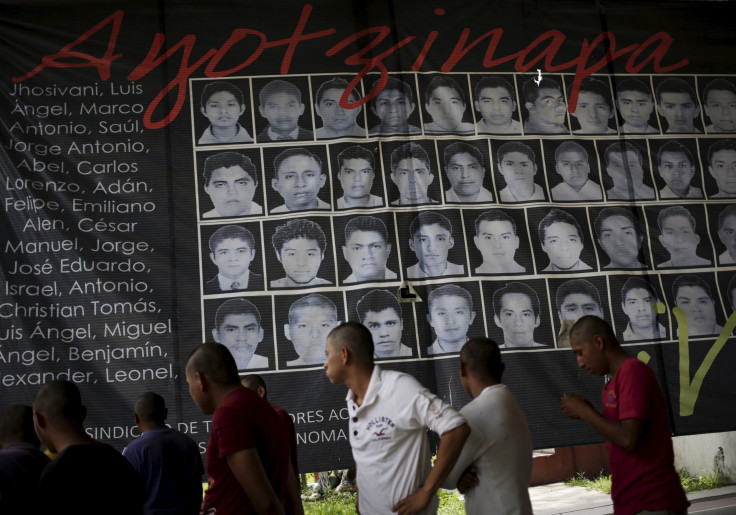Probe Into Disappearance Of 43 Mexican Students Is Flawed: Lawyers

By Anahi Rama and Lizbeth Diaz
AYOTZINAPA, Mexico (Reuters) -- Mexico's investigation into the abduction and apparent massacre of 43 students last year is plagued with errors and omissions and key parts may need to be redone, a review of the evidence shows.
The government's team lost evidence, did not properly investigate some leads and failed to provide scientific proof to back up its account that the students were abducted and incinerated and their remains dumped in a river, lawyers familiar with the case documents say.
The government says its investigation is thorough and proves the students were murdered by a drug cartel in league with corrupt local police who mistook them for members of a rival gang and burned them to ashes at a rural garbage dump.
But evidence of flaws in government case documents reviewed by Reuters include how municipal and federal police and the army knew of the students' movements before they were abducted in the southwestern city of Iguala last September.
That undermines the government's assertion that local police confused the students with members of a criminal group called Los Rojos (The Reds), rivals of the Guerreros Unidos (United Warriors) gang that it says murdered them.
Lawyers who have seen the government's case file found a host of problems and say authorities cut corners because they were in a hurry the close the case, which drew international criticism.
"There is evidence gathered by investigators that doesn't hold up to public scrutiny," said Santiago Aguirre, a lawyer for families of the students, who all attended a teacher training college in the town of Ayotzinapa.
Some suspected hit men arrested in the case and on whose testimony the government's account largely rests have claimed they were tortured, independent lawyers familiar with the case say. If proven, that could leave the investigation in tatters.
The government says the killers were so thorough in burning the students' remains that it was only possible to identify one of the victims.
It also rejected allegations that the army or federal police may have been involved in the disappearances.
Reuters was not able to review all of the evidence from the government's investigation. The documents it did review were provided by lawyers with access to them.
They say there is no scientific proof to back up the government's account and that prosecutors did not follow basic protocols, such as reviewing phone records of the students, their relatives and police officers the night of Sept. 26.
Some lines of investigation were not pursued until six months later, when a group of experts from the Inter-American Commission on Human Rights (IACHR) arrived in Mexicoto investigate the students' disappearance.
The team, which includes seasoned former prosecutors from Guatemala and Colombia, had access to the case files and began to poke holes in the case.
It will present a report with its findings on Sunday. The conclusions may throw the government's version of events into question and shine a spotlight on chronic flaws in Mexico's justice system.
In January, President Enrique Pena Nieto drew strong public criticism when he urged Mexicans to move on and put the tragedy behind them.
"We cannot remain trapped in this moment of sorrow, tragedy and pain in Mexico's history," he said.
FLAWS
Video footage of security cameras in the area where some of the students were last seen has vanished and only recently did prosecutors review the security cameras at a bus station where the police first approached the students.
The students' clothing was left in two different prosecutor's offices and overlooked until last month.
Almost a year later, some top suspects have still not been captured. They include two men the government says ordered the students' murder, local police chief Felipe Flores and drug gang hit man Gilberto Lopez.
The president's office, the attorney general's office and the army declined to comment on Reuters' findings.
The IACHR experts conducted dozens of interviews with detainees and witnesses, and examined the possible role of an army battalion located only a few blocks from where most of the students are believed to have been abducted.
The team was denied interviews, however, with 26 soldiers who had contact with the students that night.
Survivors of the police and gang attacks that night told Reuters they think the army, which has been accused by local human rights groups of hundreds of disappearances in Guerrero since the 1960s, should be probed.
"They have been the specialists in disappearing people in Guerrero," Francisco Sanchez, one of around 20 students who escaped the attack.
He and others say they have since received threats and one of them was kidnapped and beaten by people he did not know.
"The fear will always be here, mostly because we know how the people in the state and the government work," Ernesto Guerrero, a survivor, said.
"But within that fear, there is also another feeling, which is rage ... We are going to keep going until they tell us what happened to our classmates."
(Tranlsated by Joanna Zuckerman Bernstein; Editing by Simon Gardner and Kieran Murray)
© Copyright Thomson Reuters 2024. All rights reserved.











